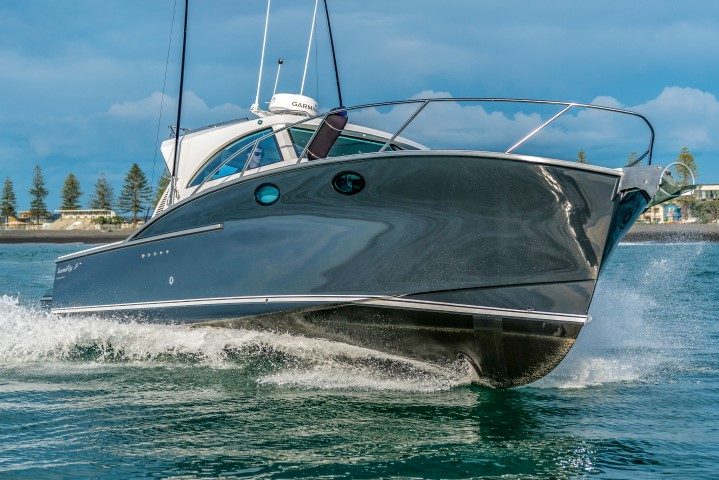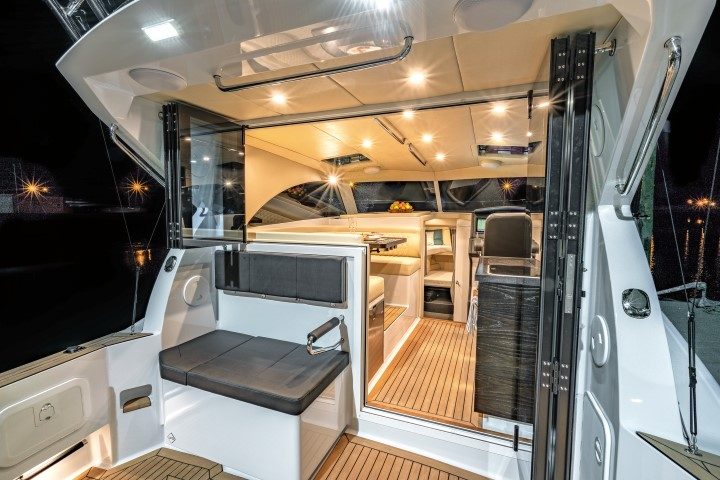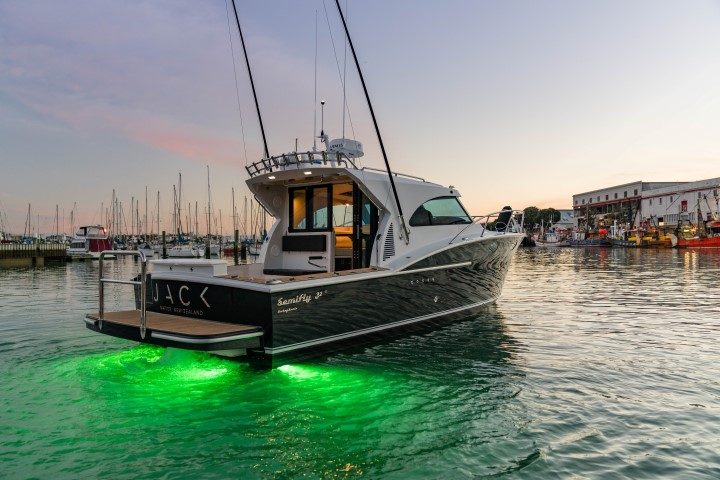‘Behemoth’ is a word which springs to mind or, perhaps more nautically, ‘leviathan’.
- Strong, light, rigid hull
- Exceptional finish inside and out
- Excellent fuel economy
- Hull doesn't pound
- Great flow

The latest version of the popular Dickey 32 expands its appeal and performance.
When Mike Hunter reviewed the first Dickey 32 back in December 2008 it read like he had written it at the Boating New Zealand Christmas party. He appeared under the influence, or drunk-in-charge-of-a-pencil as it is called in writing circles.
He waxed on about quality, design and detail and kept mentioning Lotto. He was in love and he was gonna buy one of these boats as soon as he got a raise from the editor. I could smell the rum on his breath.
Ten years on when the current editor approached me to do the review of the latest version of the Dickey 32 – named Jack – I was determined not to fall into the same trap so I approached it all with the sobriety of a monk.
Design
The first thing the sober mind notices about the new Dickey 32 is that the hull and deck design have not changed from the original model. This shows that the hours of designing and detailing put in by Dennis Harjamaa and the Dickey team back in 2008 achieved that rare condition of timeless design.

The distinctive plumb bow, sweeping sheer and chine detail, capped off with a well-proportioned pilothouse, give the Dickey 32 the aspect of an elegant, modern classic.
The 32 Semifly sits firmly in the middle of the Dickey range and like the others straddles the family-to-fishing spectrum well. While the owners all have different ways of using the boats, they all agree on the magic feel behind the helm. It’s almost like Dickey Boats have their version of the Colonel’s 11 herbs and spices – and in a short visit I was only able to decipher a few of them.
Due to the alloy construction method and the company mantra of customer service, each boat off the production line can be customised. Owners have significant input into the set-up, and as the latest 32 is the third one for the Napier-based owner, there have been some small refinements in the details of this great design.

Construction
To see a Dickey 32 hull in the fabrication phase is to see one of the ingredients in the Dickey version of the 11 herbs and spices. The CNC-cut alloy panels are laid up in an interlocking lattice framework that looks like the structure of a ship.
This makes for a lightweight but strong structure with full-length longitudinal girders, traverse bulkheads and frames at 650mm centres. Two of the larger longitudinals make a slightly wider sweep and become the mounting structure for the engine. This plugs the power straight into the hull.
The result is a seriously-strong structure which is built to last and will not flex or twist even in the biggest seas, making this boat truly offshore-capable.

On top of this base structure there are many hours of work in the finishing and detailing. The thickness of the aluminium skin varies throughout the vessel, with the lightest section being 4mm and the heaviest 14mm.
Even a close inspection from the dock will have you fooled into thinking this is a glass-fibre composite boat. There are over two thousand man-hours in the paint shop alone and this is one high-end finish that’s built to last.
Power
The original Dickey 32 had a Volvo 370 D6 diesel running through an A4 duo-prop sterndrive. For Jack this has been upped to a Volvo 400 D6. It has plenty of power and, counter-intuitively, gives economy over a wider range of speeds.
The Volvo lives under the aft deck and is accessed by a substantial hatch on an electric hoist. With the hatch open there’s plenty of room to get around the engine and, with white bilges there’s a good chance the engine will be maintained and any leaks spotted well before they come an issue.

The raw water intake is a dual system which feeds from the standard seacock or from the sterndrive which reduces the chances of plastic bag ruining your weekend.
Ahead of the engine bay through a soft wall bulkhead is the pump room, which contains all the tankage, pumps, electrical brains and batteries. Access is through a removable panel in the owner’s stateroom and it is nice to have all this in one place rather than having to ferret under bunks and inaccessible corners of the boat.
The power plant is supplied with a 550-litre diesel tank, which combined with the economy of the design, gives Jack a more than 400-nautical mile cruising range.
Layout
A walk through the Dickey 32 is a feast for the senses. Starting at the stern duckboard, which cleverly hides the cutaway stern and sterndrive, there is a simple stainless rail that hinges down to become a boarding ladder for the swimmers.
All the wet fun of the duckboard is separated from the commodious cockpit by a walk-through transom either side of the professional-scale bait station which is complete with live bait tank, tuna tubes, rubbish bin for the fishy stuff and high density cutting board.
The aft deck is laid out in durable Tek-Dek and is cambered to aid self-draining. The Tek-Dek is also used on the wide coamings designed with the fisher folk in mind. At the forward end of the cockpit is a comfortable, aft-facing seat that contains a large top-loading isotherm freezer to keep the crew fed.

The transition into the saloon has a small step to define its edge and keep any errant water out. This is finished off with folding doors that enclose the saloon for those cold winter days when the Eberspacher diesel heater is going.
Immediately to starboard is the galley with hob, sink, fridge and oven surrounded by ample storage space. To port is the saloon in a comfortable wrap-around seat and table in white trim.
The helm station is to starboard and contains a suite of Garmin instruments including plotter, radar and depth sounder. All the information is easy to read at a quick glance and is nicely shielded from glare by some pleated custom dash trim.
Instead of the normal collection of switches Jack has the CZone system which intelligently tracks through cruising, dock and hibernation modes, sending all the information back to the Sentinel app on your phone which can remotely monitor the systems. This saves the embarrassment of talking to yourself while trying to remember what to switch on and off on the breaker panel when you leave the boat.

Stepping down into the accommodation section of the boat there are some well thought out spaces. A full queen-size bed in the owner’s cabin is to port and a head to starboard with a toilet and the luxury of a stand-alone shower compartment.
The lower port side V berth has been sacrificed for some enormous storage space in draws and lockers. The storage is such that the owner can have a generous collection of fishing gear aboard without it cluttering up the stylish layout.
On the Water
There is a reason Dickey Boats does not have a lavishly-funded marketing department to its business. One trick on the helm and the boats sell themselves.
While the great design, engineering and attention to detail are nice, it is what the boat feels like that ultimately counts. Our boat review occurred on one of those brilliant Hawke Bay days with no wind and a small dying swell.
Try as I might I could not get Jack to pound nor even get so much as a creak in the joinery. This is where the 11 herbs and spices thing all comes into play. The hull construction and the cleverly-designed hull section meant that the ride was like a 1970s Cadillac.

Out of the blocks the Volvo 400 D6 has plenty of power, but thanks to a well-insulated engine room the sound in the saloon is more like a distant throb. Even at speed around 27 knots her flared chines held well in the turns with a sure-footed grip.
The light, stiff hull mixed with a long waterline length means excellent economy, which makes offshore work possible. Between 16 knots and 27 knots boat speed, fuel consumption seems to remain constant at around 2.5 litres a nautical mile.
This is a large sweet spot that allows for a considerable range of sea states that will keep the family in all day comfort or get you back from an offshore fishing trip when it cuts up rough.
Having experienced the Dickey 32 I take back all the aspersions I cast on Mike Hunter who reviewed the original. He gave the boat an 11 out of 10, but he wasn’t drunk, only under the influence of one of the finest alloy launches of its size in the world.
After a magic day on the water I wrote up my notes in the Napier airport bar with rum in hand and upped Mike Hunter’s assessment to a sobering 12 out of 10.
‘Behemoth’ is a word which springs to mind or, perhaps more nautically, ‘leviathan’.
White Pointer has earned the respect of discerning customers in New Zealand and Australia, attracting a loyal and ever growing following for its high-quality, rugged and totally dependable aluminium trailer boats.
The hardtop SP635 shares the same underpinnings as the popular SF 635 which was a completely new model back in 2020.
The pride and joy of a multi-generational family, Bliss resides on a pier that’s home to a couple of other Elite motor launches – Sandspit Marina is a hot-spot for the Bill Upfold-designed vessels, with several calling this small marina home.